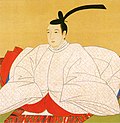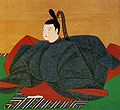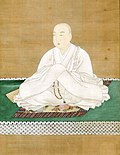and Li Chong included in the Book of Jin: 今九域同規,大化方始,臣等以為宜皆蕩除末法,一擬古制,以土斷,定自公卿以下,皆以所居為正,無復懸客遠屬異土者。 然承魏氏凋弊之跡,人物播越,仕無常朝,人無定處,郎吏蓄於軍府,豪右聚於都邑,事體駁錯,與古不同。謂九品既除...
35 KB (3,518 words) - 09:56, 21 June 2024
specifically identified by more than one era name or nengō. While Kugyō (公卿) is a collective term for the very few most powerful men attached to the court...
16 KB (895 words) - 22:17, 9 June 2024
specifically identified by more than one era name or nengō. While Kugyō (公卿), is a collective term for the very few most powerful men attached to the...
15 KB (1,431 words) - 15:23, 8 June 2024
specifically identified by more than one era name or nengō: While Kugyō (公卿) is a collective term for the very few most powerful men attached to the court...
12 KB (1,119 words) - 22:15, 9 June 2024
Kugyō (公卿) is the collective term for the very few most powerful men attached to the court of the Emperor of Japan in pre-Meiji eras. The term generally...
6 KB (743 words) - 01:21, 25 March 2024
wished to speak to the emperor. 至漢興,高祖至暴抗也,然籍孺以佞幸;孝惠時有閎孺。此兩人非有材能,徒以婉佞貴幸,與上臥起,公卿皆因關說。 Gaozu's example of effectively elevating a male lover to the top of the...
2 KB (266 words) - 14:11, 13 June 2024
as Sutoku's mausoleum. It is formally named Shiramine no misasagi. Kugyō (公卿) is a collective term for the very few most powerful men attached to the court...
15 KB (1,367 words) - 13:20, 17 June 2024
in advance, being the same as their reign names.[citation needed] Kugyō (公卿) is a collective term for the very few most powerful men attached to the court...
23 KB (2,160 words) - 22:16, 9 June 2024
and after the Li Ji Unrest. Afterwards, "Jin ha[d] no princely house" (晉無公卿) and its political power diffused into extended relations of the ruling family...
10 KB (1,052 words) - 18:10, 5 March 2024
called Fukakusa no kita no misasagi (深草北陵) in Fushimi-ku, Kyoto.: 423 Kugyō (公卿) is a collective term for the very few most powerful men attached to the court...
20 KB (2,075 words) - 22:15, 9 June 2024
tomb called Fukakusa no kita no misasagi (深草北陵) in Fushimi-ku, Kyoto. Kugyō (公卿) is a collective term for the very few most powerful men attached to the court...
13 KB (1,129 words) - 22:17, 9 June 2024
Heian Period] (in Japanese). Azekura Shobo (校倉書房). ISBN 978-4-7517-3940-2. 公卿補任 [Kugyō Bunin] (in Japanese). Yoshikawa Kōbunkan (吉川弘文館). 1982. Kitayama...
22 KB (2,769 words) - 07:39, 5 June 2024
by more than one era name (nengō). Kōnin (810–824) Tenchō (824–834) Kugyō (公卿) is a collective term for the very few most powerful men attached to the court...
11 KB (1,020 words) - 22:16, 9 June 2024
Houhanshu vol. 69. (張讓、段珪等困迫,遂將帝與陳留王數十人步出穀門,奔小平津。公卿並出平樂觀,無得從者,唯尚書盧植夜馳河上,王允遣河南中部掾閔貢隨植後。貢至,手劔斬數人,餘皆投河而死。明日,公卿百官乃奉迎天子還宮,以貢為郎中,封都亭侯。) Houhanshu vol. 69....
16 KB (2,335 words) - 22:10, 9 June 2024
显宗遂就大业,初服旒冕,衣裳文章,赤舄絇屦,以祠天地,养三老五更于三雍,于时致治平矣。 "2". Book of Later Han. "二年春正月辛未,宗祀光武皇帝於明堂,帝及公卿列侯始服冠冕、衣裳、玉佩、絇屨以行事 "120". Book of Later Han. 古者有冠無幘,其戴也,加首有頍,所以安物。故詩曰「有頍者弁...
263 KB (30,017 words) - 07:33, 22 June 2024
html Archived 2010-01-25 at the Wayback Machine 慶応4年(明治元年)3月14日、明治天皇は京都御所紫宸殿に公卿・諸侯以下百官を集め、維新の基本方針を天地の神々にお誓いになりました。The Charter Oath was promulgated on the...
9 KB (1,212 words) - 03:12, 14 September 2023
Jitō's mausoleum. It is formally named Ochi-no-Okanoe no misasagi. Kugyō (公卿) is a collective term for the very few most powerful men attached to the court...
14 KB (1,169 words) - 14:50, 8 June 2024
Nakamikado, Sakuramachi, Momozono, Go-Sakuramachi and Go-Momozono. Kugyō (公卿) is a collective term for the very few most powerful men attached to the court...
12 KB (1,057 words) - 22:15, 9 June 2024
Chōkei is venerated at Shishō jinja in Totsugawa, Yamato province. Kugyō (公卿) is a collective term for the very few most powerful men attached to the court...
6 KB (517 words) - 13:12, 17 June 2024
mausoleum is the Rengebuji no misasagi (蓮華峯寺陵) in Ukyō-ku, Kyoto. Kugyō (公卿) is a collective term for the very few most powerful men attached to the court...
10 KB (1,028 words) - 22:15, 9 June 2024
Nakamikado, Sakuramachi, Momozono, Go-Sakuramachi and Go-Momozono. Kugyō (公卿) is a collective term for the very few most powerful men attached to the court...
17 KB (1,623 words) - 09:00, 18 June 2024
specifically identified by more than one era name or nengō. While Kugyō (公卿) is a collective term for the very few most powerful men attached to the court...
12 KB (1,005 words) - 22:16, 9 June 2024
Kyoto, was founded by Shōtoku in the middle of the eighth century. Kugyō (公卿) is a collective term for the very few most powerful men attached to the court...
16 KB (1,517 words) - 14:54, 8 June 2024
sacred sword was lost. The sword was one of the three sacred treasures. Kugyō (公卿) is a collective term for the very few most powerful men attached to the court...
13 KB (1,305 words) - 22:14, 9 June 2024
Emperor Seiwa is venerated at the Seiwatennō-sha near the mausoleum. Kugyō (公卿) is a collective term for the very few most powerful men attached to the court...
16 KB (1,634 words) - 22:17, 9 June 2024
Nakamikado, Sakuramachi, Momozono, Go-Sakuramachi and Go-Momozono. Kugyō (公卿) is a collective term for the very few most powerful men attached to the court...
14 KB (1,266 words) - 15:21, 8 June 2024
Kōgyoku/Seimei's mausoleum. It is formally named Ochi-no-Okanoe no misasagi. Kugyō (公卿) is a collective term for the very few most powerful men attached to the court...
14 KB (1,401 words) - 17:15, 7 June 2024
Chu-mon entryway reads tenmangu in the calligraphy of Emperor Go-sai. Kugyō (公卿) is a collective term for the very few most powerful men attached to the court...
16 KB (1,646 words) - 22:15, 9 June 2024
founded Tenjō-ji in 646 (AD). The monk is worshipped in the Gion faith. Kugyō (公卿) is a collective term for the very few most powerful men attached to the court...
11 KB (1,151 words) - 22:16, 9 June 2024
recognizes Saga no ogura no misasagi (嵯峨小倉陵) in Ukyō-ku, Kyoto as his tomb. Kugyō (公卿) is a collective term for the very few most powerful men attached to the court...
9 KB (797 words) - 13:11, 17 June 2024


























